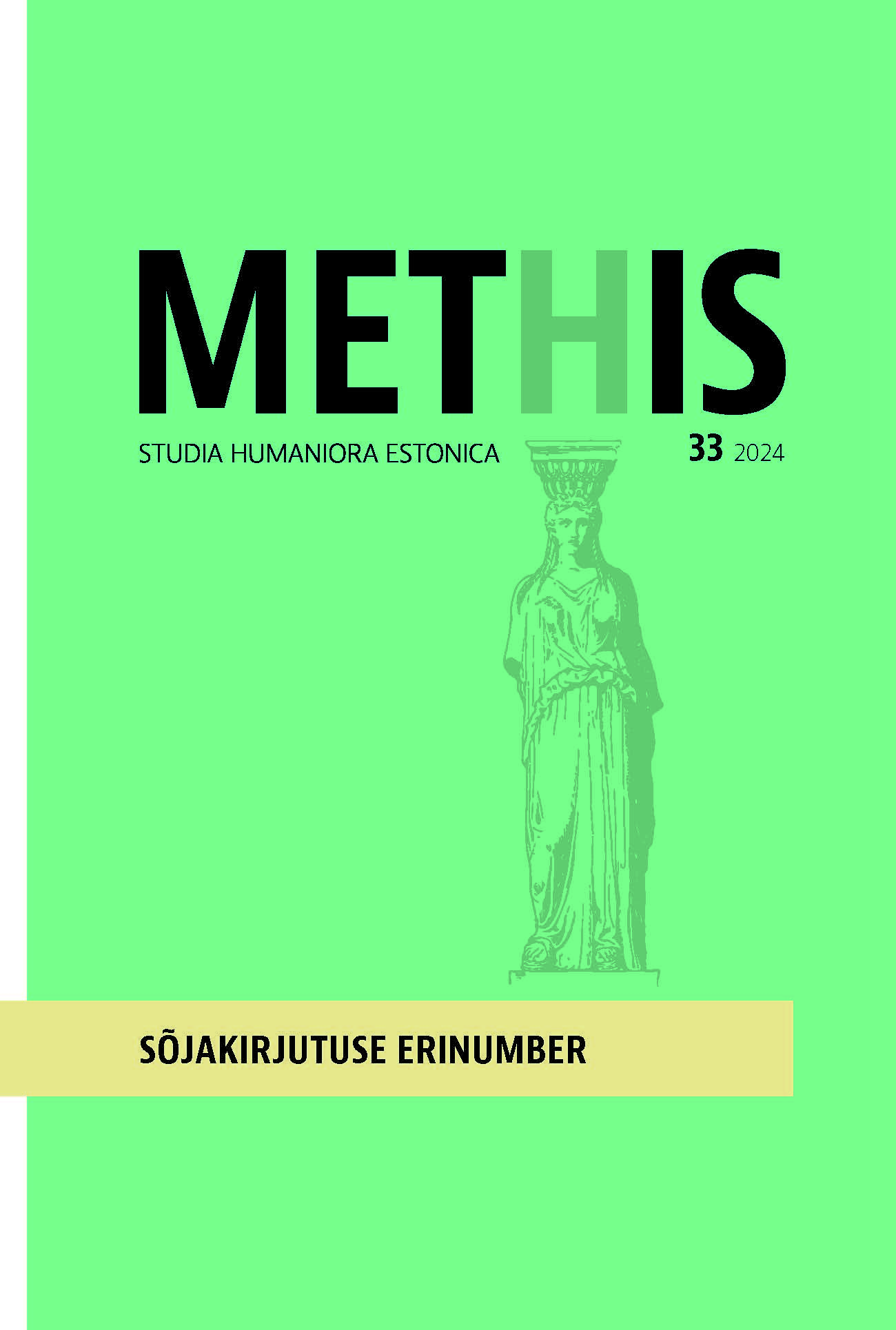Sõda eesti laste- ja noortekirjanduses / War in Estonian children’s and youth literature
DOI:
https://doi.org/10.7592/methis.v26i33.24133Keywords:
war in children’s and young adult literature, Estonian children’s and young adult literature, motif, theme, Estonian history, sõda laste- ja noortekirjanduses, eesti laste- ja noortekirjandus, motiiv, ainestik, teema, Eesti ajaluguAbstract
Teesid: Tõukudes juba kolmandat aastat käivast sõjast Ukrainas, millele eesti autorid on reageerinud kiiresti ja erksa meelega, võtab artikkel vaatluse alla sõjateema kajastuse eesti algupärases laste- ja noortekirjanduses läbi aegade. Alates kõige varasematest juturaamatutest 18./19. sajandi vahetusel, mis sisaldavad tekste sõjaväeteenistusse saadetud noormeestest, kuni kõige uuemate sõjast rääkivate pildiraamatuteni 2023. aastast annab artikkel kronoloogilise ülevaate lastele ja noortele suunatud teostest, mis kujutavad sõda, okupatsioone, revolutsioone või mõnd muud militaarse iseloomuga sündmust ning nendega seotud aspekte. Artikkel keskendub valdavalt eraldi kaante vahel ilmunud teostele, mis moodustavad vaid ühe osa mahukast tekstikorpusest, toob välja algupärases sõjateemalises laste- ja noortekirjanduses kõige enam kasutatud ainestikud ja motiivid ning loetleb sõjateema edasise uurimise võimalusi.
The article gives a historical overview of war-themed texts in Estonian children’s and youth literature. The choice of the research topic is motivated by Russia’s military invasion of Ukraine in February 2022, which also changed the sense of security in our region. It has also prompted children’s and young adult writers to reflect on war and peace, resistance and cooperation, justice and injustice in a form that is appropriate and comprehensible to young readers.
From the earliest storybooks at the turn of the 19th century, which include texts about young men conscripted into military service, to the most recent picture books about war from 2023, the article provides a chronological overview of works for children and young people depicting war, occupation, revolution or other events of a military nature and their related aspects. The article looks at works published mainly in book form, covering only part of a large corpus of texts. Texts published in journals, story collections, anthologies, school textbooks and elsewhere have been excluded for reasons of space.
The theme of war in Estonian children’s and youth literature has become topical in connection with the turning points in Estonian history (revolutions, wars, occupations), and also bears the ideological signs of the time. However, as early as the 19th century, during the period of national awakening, national mythological and romantic material (the ancient struggle for freedom and the so-called Lembitu line; the so-called Jüriöö text) was introduced into literature, and has remained topical to the present day.
The theme of war has been used more in periods when it was important to strengthen the nation’s sense of unity (the Republic of Estonia before the Second World War) or to justify regime change and new ideology (Soviet Estonia). Texts published in these periods stand out for their strong combative or combative-propagandist stance, strong and/or ideologised characters, sharp confrontations, realistic depictions of violence and death. The war texts that have appeared in free society in the last few decades are predominantly childhood memoirs of a long-ago war or occupation, although they are still generally told in an exclusionary, fragmented way through a narrative of silence. The trauma narrative has not been as topical in Estonian children’s and young people’s war literature as it has been in Western literature in recent decades.
In Estonian children’s and young adult literature, most of the war stories are realistic, with human characters and real or possible situations, with only a few animal tales. To a large extent, the way a story is presented depends on the theme, genre and the age of the reader of the text. The majority of war stories are written by men, while women’s voices can be heard in memoirs, fairy tales and, to a lesser extent, folk mythological histories. Most of the works have an autobiographical background, i.e. the writers have themselves participated in the war and/or lived under occupation. This leads to a situation in which male characters are in the foreground and the events are characterised by adventures, intense confrontations and action. Girls came to Estonian children and young people’s war literature during the over-militarised Soviet era. Although writing about war is the most difficult and problematic for young children, both from an age and education point of view, there is literature for them (picture books, books about war games).
War-themed texts in Estonian children’s and youth literature mainly pursue educational aims (stories of masculinisation, stories of cooperation, presentations of Estonian history in exile, reminiscences of tragic times in contemporary memoirs), but in certain periods political (the period of the Estonian Republic, exile) and ideological aims (Soviet Estonia) have been more prominent.
The article outlines the most frequently used themes and motifs in Estonian children’s and young adult literature on war and lists possibilities for further research on war.


